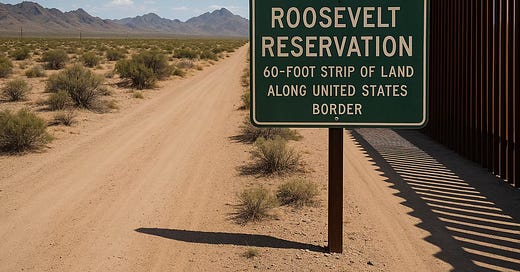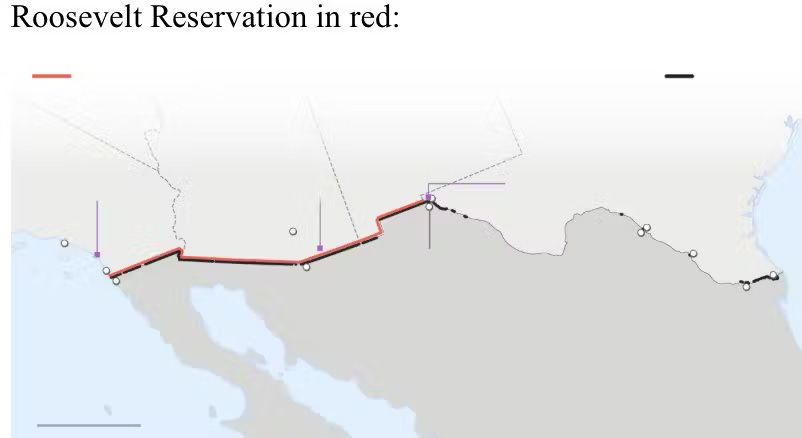President Trump Militarizes the Roosevelt Reservation to Seal the Southern Border
In a historic and aggressive move to shut down the ongoing invasion at America’s southern border, President Donald J. Trump has authorized the Department of Defense to formally militarize the Roosevelt Reservation—a federally controlled 60-foot-wide buffer zone spanning nearly 700 miles along the borders of California, Arizona, and New Mexico. Established by President Theodore Roosevelt in 1907 for the purpose of border security, the Roosevelt Reservation has until now remained largely symbolic. With this new directive, however, that changes drastically. The area will now be treated as active military property, giving the U.S. Armed Forces full legal authority to operate in and defend this border strip. Troops stationed in these zones will have the power to intercept and detain illegal aliens, subsequently transferring them directly to U.S. Border Patrol custody. This decision marks the most substantial deployment of military power for domestic border enforcement in modern American history, and it signals the federal government’s readiness to restore national sovereignty through force if necessary.
What makes this declaration even more impactful is its seamless alignment with existing state-level operations—particularly in Texas. Unlike its western counterparts, Texas is not included within the Roosevelt Reservation because the federal government owns significantly less land at the border in that state. However, Governor Greg Abbott has already taken matters into his own hands by deploying thousands of National Guard troops through Operation Lone Star, which has operated under similar principles of deterrence and detention. In this way, President Trump’s militarization of the Roosevelt Reservation effectively creates an unbroken, multi-state strategy against unlawful migration. With the federal military now backing up Border Patrol operations in California, Arizona, and New Mexico, and state troops reinforcing efforts in Texas, the southern border is being sealed off through synchronized military and law enforcement action—essentially forming a unified southern shield.
The implications of this move cannot be overstated. It is a clear declaration to drug cartels, human traffickers, and foreign nationals that the era of open borders and catch-and-release is over. Critics will argue that this strategy flirts with the boundaries of the Posse Comitatus Act, but legal experts note that because the military is not engaging in traditional law enforcement duties—such as making arrests or prosecuting crimes—but rather in defensive border security and detainee transfer operations, the action remains within the scope of constitutional authority. The deployment also sends a sharp message to foreign governments, especially Mexico, that American soil will no longer be used as a thoroughfare for mass illegal crossings. Supporters hail this as the long-awaited execution of a real border strategy that puts America first and restores lawful entry as the only permissible path into the country. For millions of Americans, especially those living along the southern border who have endured years of violence, trespassing, and insecurity, this militarization offers long-overdue relief and the promise of restored national control.
The Roosevelt Reservation is a 60-foot-wide strip of land that runs along much of the United States' southern border with California, Arizona, and New Mexico. It was established by President Theodore Roosevelt in 1907 through a presidential proclamation. The intent of this reservation was to create a federally controlled buffer zone to protect national interests along the international boundary with Mexico.
Here are the key details:
🔹 Origin and Purpose
Established: May 27, 1907, by Proclamation No. 758 by President Theodore Roosevelt.
Purpose: To prevent obstructions along the U.S.-Mexico border that might interfere with federal oversight, customs, immigration enforcement, and border security.
Quote from Roosevelt:
“...to prevent the erection of any building or other obstruction within sixty feet of the international boundary…”
🔹 Geographic Scope
Extends 60 feet north of the U.S.-Mexico border.
Covers approximately 700 miles of the nearly 2,000-mile-long border.
It does not extend through Texas, as most of the land along the border in Texas is privately owned, not federally held.
🔹 Modern Use
In recent decades, especially since post-9/11 border security concerns and the Secure Fence Act of 2006, the Roosevelt Reservation has become increasingly important for:
Border fence and barrier construction
Surveillance infrastructure
Patrol access roads
It allows the federal government to build and maintain security infrastructure without negotiating with private landowners.
🔹 Legal and Political Significance
Because it's already federal land, it streamlines construction and security measures without requiring eminent domain (which is often controversial).
Has been a key asset for border wall and technology deployment under multiple presidential administrations, especially Trump's.
Here is the EO
NATIONAL SECURITY PRESIDENTIAL MEMORANDUM/NSPM-4
MEMORANDUM FOR THE SECRETARY OF DEFENSE
THE SECRETARY OF THE INTERIOR
THE SECRETARY OF AGRICULTURE
THE SECRETARY OF HOMELAND SECURITY
SUBJECT: Military Mission for Sealing the Southern Border of the United States and Repelling Invasions
As the Chief Executive and Commander in Chief, the United States Constitution empowers me to direct the various elements of the executive branch to protect our homeland and ensure the territorial integrity and sovereignty of the United States in the manner I deem most efficient and effective, consistent with applicable law. Our southern border is under attack from a variety of threats. The complexity of the current situation requires that our military take a more direct role in securing our southern border than in the recent past. Through Executive Order 14167 of January 20, 2025 (Clarifying the Military’s Role in Protecting the Territorial Integrity of the United States), I assigned the Armed Forces of the United States the military missions of repelling the invasion and sealing the United States southern border from unlawful entry to maintain the sovereignty, territorial integrity, and security of the United States. This memorandum provides additional guidance on securing the southern border to the heads of certain executive departments.
Section 1. Policy. (a) to accomplish the military missions described in Executive Order 14167, and to ensure the safety and security of the military and other Federal personnel in areas of military operations within Federal lands along the southern border, the Secretary of Defense, the Secretary of the Interior, the Secretary of Agriculture, and the Secretary of Homeland Security shall take all appropriate actions:
(i) to provide for the use and jurisdiction by the Department of Defense over such Federal lands, including the Roosevelt Reservation and excluding Federal Indian Reservations, that are reasonably necessary to enable military activities directed in this memorandum, including border-barrier construction and emplacement of detection and monitoring equipment; and
(ii) to provide for transfer and acceptance of jurisdiction over such Federal lands in accordance with applicable law to enable military activities directed in this memorandum to occur on a military installation under the jurisdiction of the Department of Defense and for the designation of such Federal lands as National Defense Areas by the Secretary of Defense.
(b) The Secretary of the Interior shall allow the Secretary of Defense to use those portions of the Roosevelt Reservation not yet transferred or withdrawn under this memorandum. In accordance with Proclamation 10886 of January 20, 2025 (Declaring a National Emergency at the Southern Border of the United States), 43 U.S.C. 155 is hereby invoked and the Secretary of the Interior may make withdrawals, reservations, and restrictions of public lands to provide for the utilization of public lands by the Department of Defense to address the emergency at the southern border, without regard to any limitation on withdrawals otherwise applicable under the terms of the Engle Act, 43 U.S.C. 155-158.
(c) The Secretary of Defense may determine those military activities that are reasonably necessary and appropriate to accomplish the mission assigned in Executive Order 14167 and that are necessary to protect and maintain the security of military installations, consistent with section 2672 of title 10, United States Code, and the longstanding authority of a military installation commander to exclude persons from a military installation, as recognized in section 21 of the Internal Security Act of 1950 (50 U.S.C. 797) and 18 U.S.C. 1382.
(d) In carrying out activities under this memorandum, members of the Armed Forces will follow rules for the use of force prescribed by the Secretary of Defense.
Sec. 2. Phased Implementation. The Secretary of Defense, the Secretary of the Interior, the Secretary of Agriculture, and the Secretary of Homeland Security will initially implement this memorandum on a limited sector of Federal lands designated by the Secretary of Defense. Within 45 days of the date of this memorandum, the Secretary of Defense shall assess this initial phase. At any time, the Secretary of Defense may extend activities under this memorandum to additional Federal lands along the southern border in coordination with the Secretary of Homeland Security, the Assistant to the President and Homeland Security Advisor, and other executive departments and agencies as appropriate.
Sec. 3. General Provisions. (a) Nothing in this memorandum shall be construed to impair or otherwise affect:
(i) the authority of the Secretary of Defense to authorize and request that State Governors order members of the National Guard under authority of title 32 of the United States Code to conduct Department of Defense activities, including as appropriate to support law enforcement activities under the responsibility of the Attorney General or the Secretary of Homeland Security, if requested by such official;
(ii) the authority granted by law to an executive department or agency, or the head thereof; or
(iii) the functions of the Director of the Office of Management and Budget relating to budgetary, administrative, or legislative proposals.
(b) This memorandum shall be implemented consistent with applicable law and subject to the availability of appropriations.
(c) This memorandum is not intended to, and does not, create any right or benefit, substantive or procedural, enforceable at law or in equity by any party against the United States, its departments, agencies, or entities, its officers, employees, or agents, or any other person.
DONALD J. TRUMP





